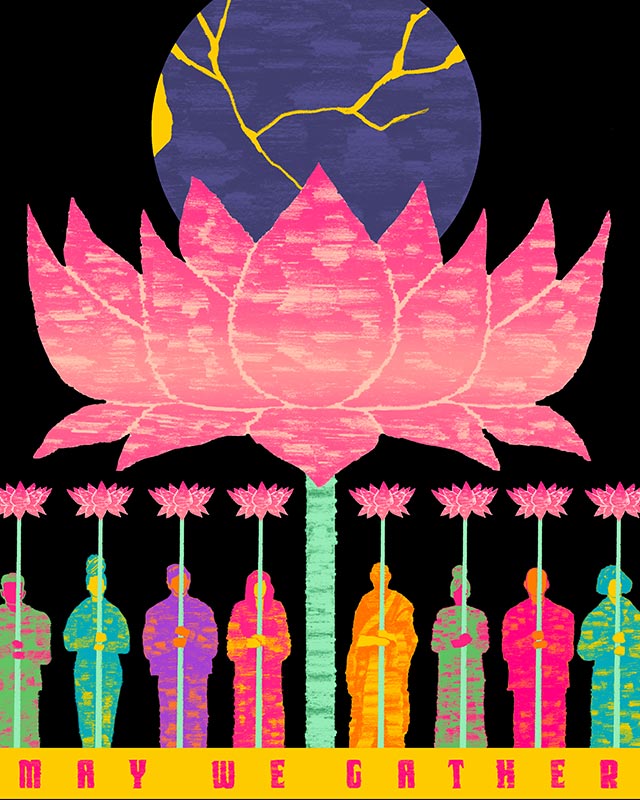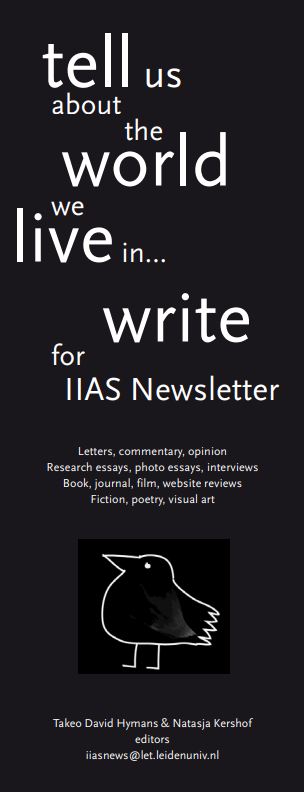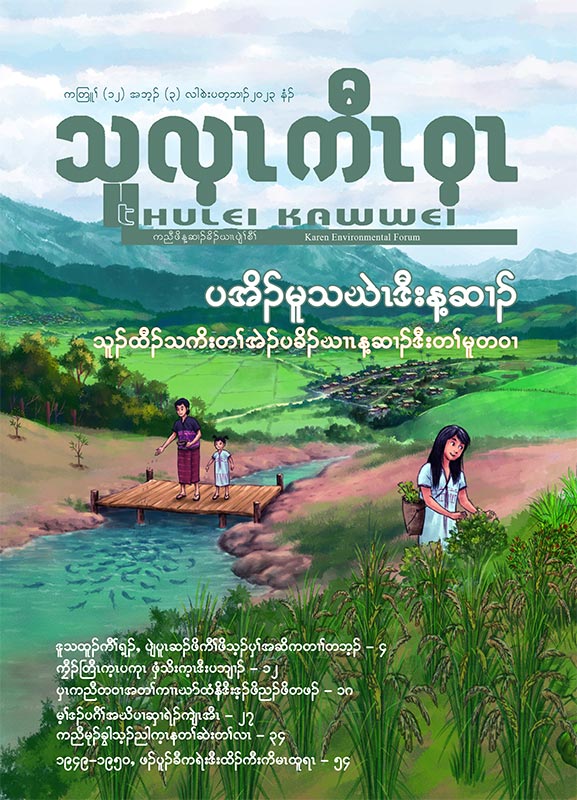"The Newsletter" at 30: On Asia in the World
The Newsletter is IIAS’s flagship journal, and it is the most widely read publication of its kind in Asian Studies. It is produced three times a year in print and online, and offers its authors and readers a critical forum in which to discuss and think about Asia.
In 1993, The Newsletter started out with the aim to “create transparency into what is happening in the field of Asian Studies” (NL1, p. 1). We still aim to do so, but in the course of three decades, what this means has undergone several transformations. Importantly, The Newsletter has evolved in both content and function. What began as a tabloid for colleagues to share information on research, conferences, and publications has developed into a rich collection of substantial writings for a wide readership interested in Asia. Together with its digital platforms The Blog and The Channel, it offers insight into current issues as well as long-term research.
Below, as the current editors of The Newsletter, we look back at 30 years of our journal and anticipate its 100th issue in 2025. We chart the changes that we have implemented since our arrival in July 2021, and show how they connect to and expand on some of the ideas of our predecessors, firmly embedding Asia and its study in the wider, contemporary world.
Asia through places and voices
From its very first issue, The Newsletter took upon itself the coordination of scientific research in Asian Studies, and it published news about institutes, conference reports, calls for papers, lectures, awards, and events. This was structured regionally and divided into “General News,” “South Asia,” “Southeast Asia,” and “East Asia.” Another, interesting, regional designation was “Insular Southwest Asia,” which covered the islands in the Western Indian Ocean, from the Maldives to Madagascar. As our pages gradually contained more thematic articles, the editors decided to drop regional designations, finding it difficult to decide where to place articles “that defied the regional structure: Asian art exhibitions worldwide, research on Asians living in Europe, how Arabs perceive Asians, and the Japanese automobile industry in Europe” (NL2, p. 2).

Graphic of “May We Gather, a National Buddhist Memorial Ceremony for Asian- American Ancestors.” Photo downloaded from MayWeGather. org and reprinted in The Newsletter accompanying the article “Doing No Harm: Mindfulness, (Western) Buddhism, Appropriation, Systemic Racism” (NL91, p. 4-5).
Indeed, “Asia” can focus on specific locales, but is also a fluid – at times even elusive – entity. The Newsletter aims to offer an understanding of “Asia” as both. For instance, it continues to sustain and expand our network of regional partners, and it recognizes the importance of place in current debates, particularly those debates held in the Global South, or between the South and the North. Simultaneously, we are a platform for articles that question mapping and bordering, and we remain committed to offering alternative frameworks for approaching “Asia.” These can be articles on actual, alternative maps, such as those made by Javanese mapmakers (NL95, p. 6-7, see also Fig. 3 on p. 22-23), or research that traces the trajectory of objects that move between countries and continents (NL95, p. 39-48), or writings on race and the migrant experience (NL95, p. 14-15), or works that explore understandings of such concepts as “mindfulness” (NL91, p. 4-5).
Beyond attending to the question of place, recent articles increasingly emphasize diverse voices, and we actively solicit articles from underrepresented groups. These include junior scholars, female authors, and Indigenous partners, as well as colleagues from, or working on, underrepresented parts of Asia. Our latest example is a collection of articles co-written and illustrated by Indigenous authors (NL94-). Indigenous ontologies everywhere emphasize the interconnectedness between Indigenous Peoples, lands, forests, water, and wildlife. Just like the stories of objects and people on the move, these worlds of knowledge take us across official borders. They establish a deeper connection between “Asia” and other parts of the world.
Authors and “thinker-makers”
In 2015, our predecessors posited the idea of “The New Asia Scholar” (NL72, p. 17-40). In a collection of articles, they noted “an increasing demand for alternative scholarship within Asian Studies, for a move away from Western scholarship, and for the development of ‘reverse discourses’ in order for non-Western scholarship to theorize back at the West.” The editors write that “Asia is a breeding ground for new knowledge and theory” and that emerging local Asian networks and centers of knowledge are seeking to interact with the rest of the academic world. They also discuss how “university and museum programmes draw closer together,” and how “academic research on museums becomes more socially relevant to local communities.” They suggest that “to generate critically and socially-engaged scholarship, new avenues must be paved, so that research may reflect locally-embodied knowledge and understanding.”

A call for contributions to the IIAS Newsletter, c. 2006 before rebranding as The Newsletter (NL41, p. 3).
At 30, IIAS’s various programs, including The Newsletter, are fully engaged in the development of and experimentation with activities and connections that facilitate new forms of research, education, dissemination, community building, and civic engagement. For The Newsletter, one of the ways in which this has taken shape is that we have actively connected to and published the work of authors who do not define themselves as “Asia scholars” at all. This holds for the articles and illustrations by the Indigenous authors discussed above, but the push extends into much of our recent content: interviews with artists (NL89, p. 54-55), articles by filmmakers and others from the creative industries (NL92, p. 20-21), theater makers (NL92, p. 18-19), architects (NL92, p. 12-13), and curators (NL93, p. 4-7).
Creativity was always central to The Newsletter, and the first issues already included a “Museums and art” section. This section grew from a calendar of upcoming events to a series of reviews of exhibitions and artworks. The new articles by “thinker-makers” merit a platform of their own, and, in Issue #92, we introduced “The Tone,” a section with a more open conception of artistic output, featuring works of creativity and curation in the broadest terms.
Other articles by authors who are not Asianists are fully integrated into our research section, including a recent piece by a scientist, who explores the history of his grandmother, a woman revolutionary in the Indian struggle for independence (NL93, p. 14-15). In the near future, we hope to collaborate with archaeologists, geologists, and journalists, to highlight how Asia and its study are in constant communication with other worlds of knowledge and engagement.
Current issues, long-term research, and shared experiences
The Newsletter has previously considered the connection between current events and research. In 2002, a series of articles investigated how war affected the cultural objects of Afghanistan, and some of these essays are a call to action. Since 2021, we feel the need to consistently include at least one response to a current event. As The Newsletter reaches out to an increasingly wider audience, we are even more aware of the role we play in facilitating the connection between knowledge and people, and in creating a free and safe space for discussion. So far, academics and authors working for humanitarian organizations have responded to such events as the evacuation of Kabul (NL90, p. 6-7), the political turmoil in Sri Lanka (NL93, p. 10), the floods in Pakistan (NL95, p. 4-5), and the protests in Hong Kong (NL95, p. 12-13). We have also published a collection of articles on the complex question of provenance and repatriation, from the perspective of academics in Asia and Europe (NL92, p. 31-43).
Current events do not just affect research; many of the above cases have an impact on the author involved, too. The Newsletter recognizes that authors can have many different roles, and that they can be politically involved, in addition to being professionals. This dynamic does not only concern external events. In recent years, academia has changed profoundly, and scholars face more challenges than ever before, from temporary teaching contracts to citation indices. In Issue #94, a group of authors published an article on problems of mobility for scholars from the Global South. Visa-related barriers, they write, raise the question of whether mobility enhances or inhibits academic freedom (NL94, p. 8-9). We envision The Newsletter as a site for many more such publications.

After a special section dedicated to Indigenous authors [NL94, p. 31-39], IIAS supported the translation of a contribution back into the S’gaw Karen language. That translation was published in volume 12, issue 3 of the magazine Thulei Kawwei (September 2023), available at: https://kesan.asia/ category/all-resources/ magazines
We are not activistic, but we do recognize the need, and will offer space, for critique. With The Newsletter as an anchor, and its digital satellites in The Blog and The Channel, we have a suite of possibilities. Long-term research and responses to current issues work well in The Newsletter. With relatively short word counts and quick turnarounds, authors can publish their research-in-the-making as well as analyses of current situations. The Blog is ideal for thoughtful discussions, brief reflections, and critical conversations in a way that is less formal and more timely than what is possible in the print version. And our podcast episodes on The Channel create an entirely different environment and experience, as audiences listen to interviews on latest publications, discussions, and talks given at our institute. While different in their approach, all of these platforms are vehicles for learning and for sharing experiences with our audiences. In a world that is increasingly integrated yet increasingly unequal, we hope to create greater awareness of issues within and outside academia.
Making and communicating knowledge
The current structure and setup of The Newsletter and its online platforms help to make knowledge accessible to progressively wider circles of audiences, and they encourage careful consideration.
On a meta-level, “The Slate,” a new section introduced in Issue #93, specifically asks how knowledge is made. Proceeding from IIAS’s focus on education, “The Slate” invites educators and researchers to explore the debates, practices, challenges, and opportunities of 21st-century education. For the first iteration, one scholar discusses how to introduce primary- and secondary-school readers to stories about the Partition. Another elaborates on how she uses graphic novels to teach histories of Asian migration.
Generally, across our platforms, there is greater attention on the importance of different sensory experiences of Asia. More and more articles question representation and critique visual images. Podcast episodes engage our audience aurally, through recordings of music, sound, language, and accents.
As we proceed to reach out to and involve even more authors and audiences, how we make and communicate knowledge will continue to be important. In 2003 (NL32, p. 6), Prof. J.F. Staal, chairman of the committee that proposed the creation of an International Institute for Asian Studies in the early 1990s, reflected on the future of Asian Studies. Staal wrote about a need to “redress the balance,” to “evolve new terms and concepts,” and to “translate.” Indeed, much is lost in language, and while we recognize the benefits of a common language of communication, The Newsletter is experimenting with other possibilities. One example is the translation of one of the articles co-written by Indigenous authors (NL94, p. 34-35) back into their S’gaw Karen language [Figs. 4-5]. This article subsequently appeared in Thulei Kawwei, a regional print magazine popular among Karen communities in an area with limited internet connection. In addition, our podcast enables auditive experiences of other languages, and we anticipate including more of them in future episodes.
Different editorial teams have shepherded The Newsletter through multiple reinventions – indeed, a glance at the archives reveals dramatic changes in terms of design, format, tone, and substance. Yet a throughline can also be discerned across three decades of issues. The Newsletter and its satellite platforms strive to gather diverse perspectives, to increase accessibility, to critically reflect on the ever-shifting landscape of Asian Studies vis-à-vis the contemporary university, and to consistently push scholarship in new directions. In short, we remain committed to facilitating connections and novel conversations. This continuity of purpose enables The Newsletter to adapt and evolve. In the coming years, we look forward to maintaining a welcoming, constructive, and incisive forum within our pages and across our platforms.
Paramita Paul is Chief Editor of The Newsletter at IIAS.
p.paul@iias.nl
Benjamin Linder is Assistant Editor of The Newsletter at IIAS.
b.linder@iias.nl